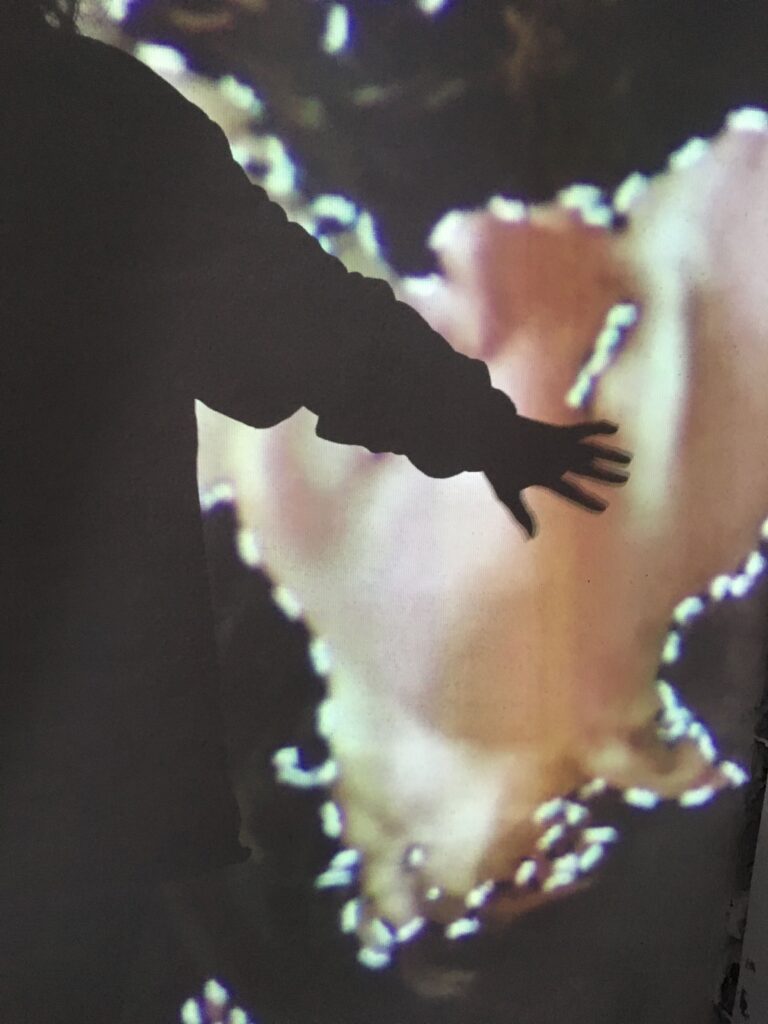This contemplative essay by Dorte Bjerre Jensen wades into the waters of gratefulness, spacetime and mutuality. It flows through the landscape like a river, letting what passes by be a surprisingly part of the journey as a tangled flow of existence, blurring the lines between human perception and the-more-than human worlds.
As the author of this article I have allowed myself to compose and decompose thoughts, images and felt sensations around the chosen theme ‘Composing Mutual Ties’, with pauses in the flow of reading by inviting you, reader, to take breaks, to contemplate and go along with proposed suggestions, and taking your time as an act of care.
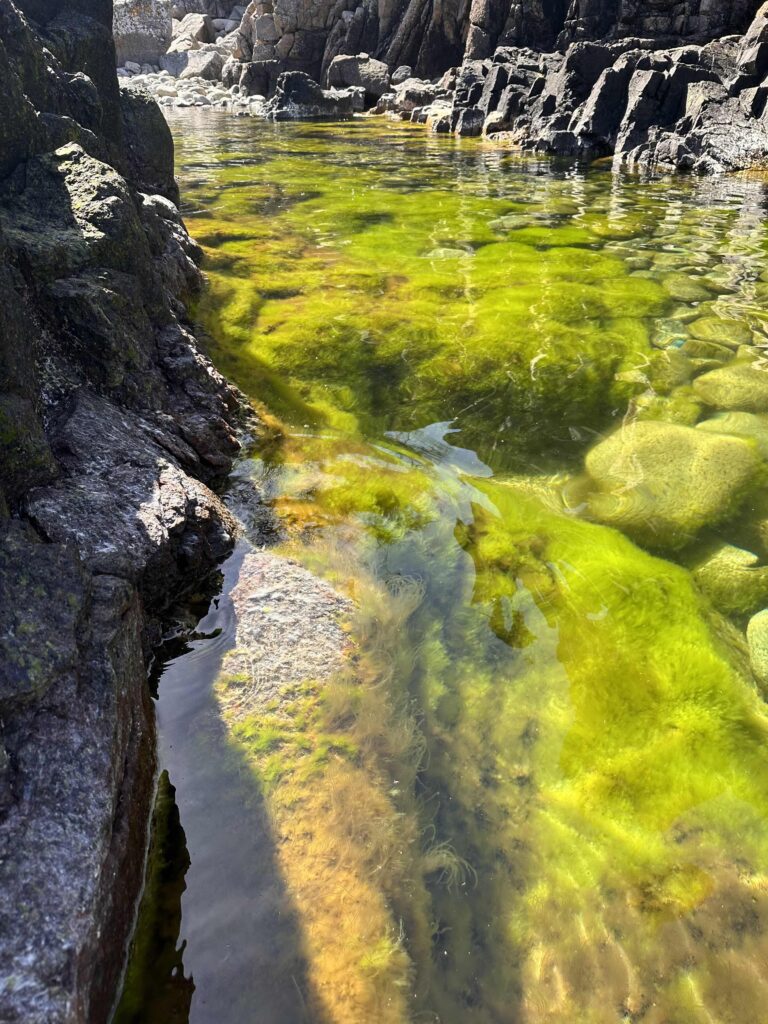
Gratitude
This article is also an in-memory-of Steve Paxton who passed away recently and left a legacy within the dance world. Steve Paxton was an American dancer, choreographer, artist and key instigator within the transformative Judson Dance Theater and Grand Union postmodern movement groups, inventor of contact improvisation in 1972. At that time he expanded the possibilities of what dance could be, developing works around basic tasks like walking or standing/The Small Dance.
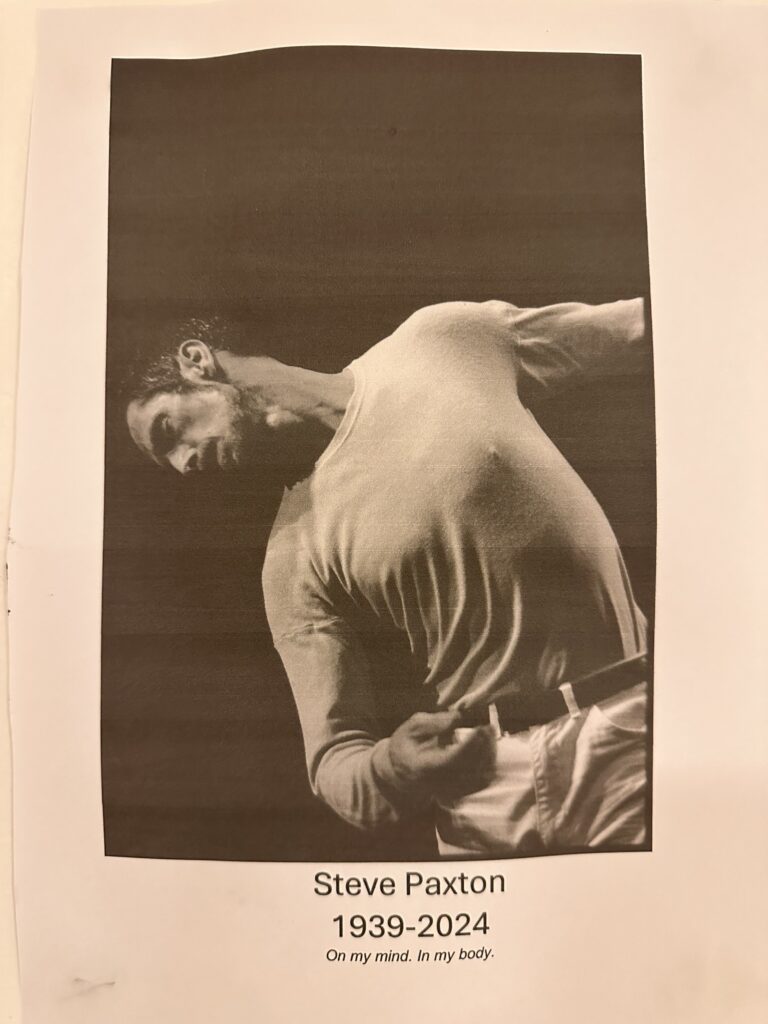
And as an art worker grounded in dance, choreography, teaching, writing and performance I am deeply inspired by his work throughout many years… and continue to be so.
A few days after his death a friend of mine texted me (just 5 min. before starting my class). I was like…no, not already, I´m not ready, no one is. But he was. I guess. This strange feeling of someone who has always been there and at the same time has become immortal, suddenly was gone was surreal. I was actually surprised how much it affected me. My legs started to shake, it spreaded to my hands, my voice and eyes.
The room was pretty full. People gathered in a circle. My voice trembled but somehow I managed to inform people about what was going on.
I suggested that everyone could think of someone who has inspired them throughout their lives.
Take a moment to recall someone who has inspired and hearted you in a special way.
In what way and when? Take your time.
You can end it by sending them your deepest gratitude.
It was such a nourishing and touching experience to be standing 45 people in a vibrating room full of love, tears and gratitude.
It also made me think of other important people in my life, how and in what way they have inspired and supported me.
What is remembered, lives!
I would like to end this passage with the act of gratitude by Alexis Pauline Gumbs, black feminist, ray of sunshine and an endless source of power and love…:
“…I respect you as so much bigger than my own understanding…Despite everything and because of everything, this is a time of gratitude and prayer.
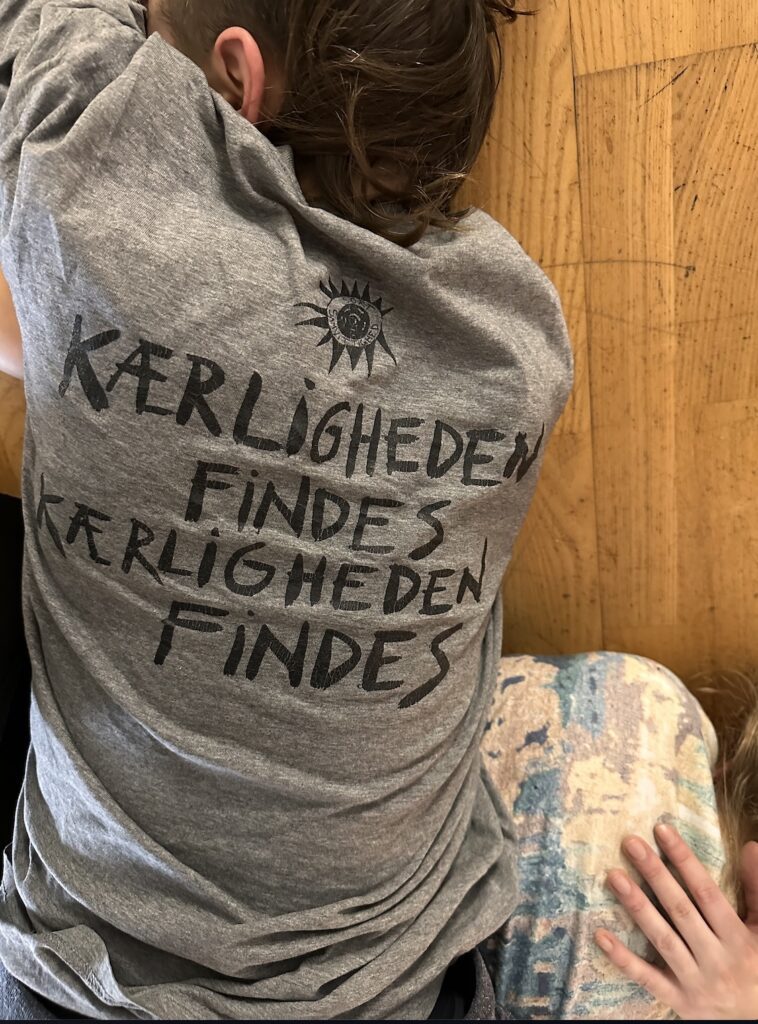
Spacetime
Allowing ourselves to be deeply grateful for a while was a very profound and heart opening start of my class that ventured into The Small Dance/The stand by Steve Paxton.
The small dance is a powerful act. A non-doing within the decision making of keeping yourself upright.
I remember it as a very challenging thing to do as a young mover, it made me a bit uneasy due to my more restless and speedy mindbody.
But it began to grow on me.

Interesting how something so simple as observing your own standing bodymind can teach you so much. What I started to notice was this highly complex situation that standing is, even though it feels as the easiest thing to do (in the beginning). In tiny details I started to understand and sense how my bodymind was this constant shifting construction, and how my attention was traveling. Nita Little, also a first mover within contact improvisation, a power house and inspirational thinker and teacher formulated this sentence: moving at the speed of your own attention.
Just try for a moment, just from where you are now, to do so, to move at the speed of your own attention.
Steve Paxton and Nancy Stark Smith also talks about how attention is magnifying sensation:
NSS: This approach uses—and this is brilliant, too—the Small Dance as a foundation for attention and for action in the Contact form.
SP: Yes. As far as I know, it’s the lowest place the consciousness will easily go.
NSS: The smallest unit of sensation that you could perceive?
SP: Yeah, and movement. It’s a reflexive movement that you can see. You can watch your heart beat. Here is the Small Dance holding you upright, balancing, and constantly changing, and—at least as I perceive it—the more you keep your awareness there, the finer and more global it becomes.
We often come to standing because we are going somewhere, but here it is standing for its own sake. And it’s not about achieving a ‘good’ standing, but practicing the art of observing and noticing. Noticing that even though we are standing still, we are always moving. Here in the words of Dumit and O´connor: “We are filled with multiplicities of micromovements: gaseous, liquid, microbial, muscular, and bony… a constantly creative adjustment of orientation, alignments, contractions, relaxations, and balancing… Attending to all this motion is fantastic; attending stretches our imaginations and feelings of embodiment.” (Dumit, O’Connor, The Senses and Sciences of Fascia: A Practice as Research Investigation). Gratitude.
And how this meditative observing practice still can be a part of your bodymind even though you are moving. I have the time to notice what is happening, but also noticing what I am not noticing, or what I think is impossible to notice in a conscious way. It’s kind of unfathomable that this whole body mass is resting on two small islands called feet when standing upright. I´m still intrigued by that. And the whole reason why we can feel these constant adjustments is because we have a dance with gravity. The body is constantly falling and catching itself.
I invite you to come to standing. If there are other people in the room you can ask them to join you.
Feel your standing body and your feet as part of the earth. Relax your body and easy breathing. Feel the weight of your arms, and your spine rising up between your shoulder blades to support your skull. While standing you will observe some small movements. It is the Small Dance. Your standing body is having a dance with gravity.
Gravity is a universal constant. A force that keeps us tethered to the earth.
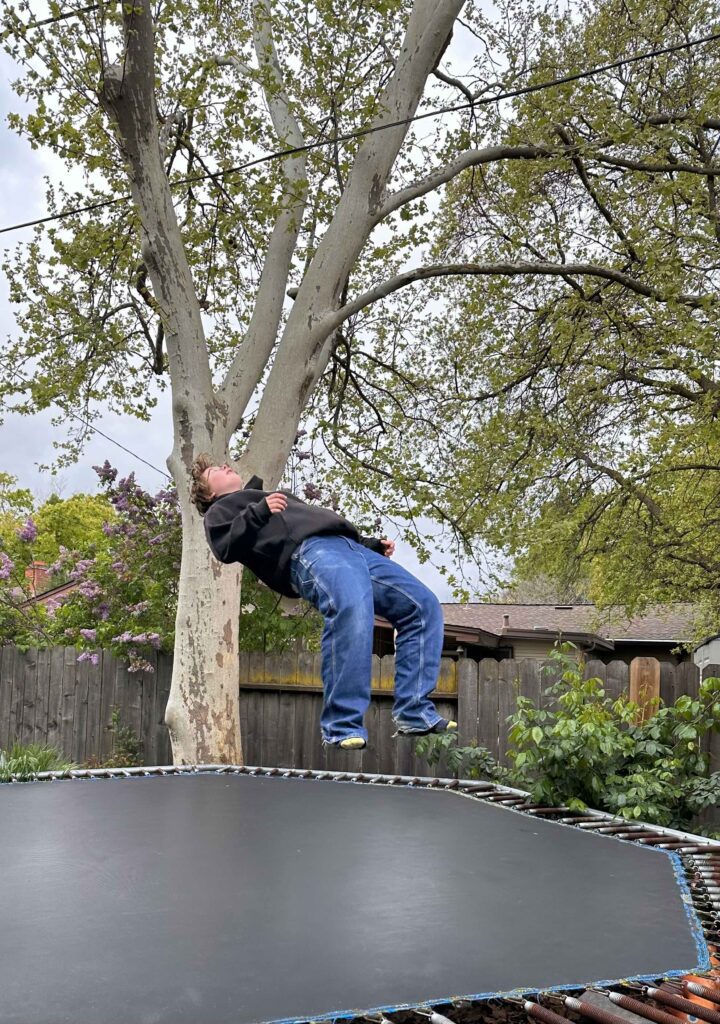
There is this little beautiful book by Steve Paxton Gravity where he circulates around the theme of gravity through early childhood memories, dreams, spherical spaces, dancing, etc. And at one point he writes:
“It’s difficult to find words to talk about the feelings of gravity…”
What do you think?
We rise and we fall constantly. With our emotional and physical bodymind
Falling head over heal
Fall apart
No chances have fallen
Fall short
Fall out
Fall out of place
Fall into place
How would falling in love be without gravity?
Sometimes when things seem to fall apart, they may actually be falling into place.
Maybe these above listed idiomatic gems could be examples of the feelings of gravity. Maybe.
Gravity is something we all have in common, humans and more-than-human-worlds. Constantly we go with it or we go against it. We rise and we fall. As a universal rhythm. It is visible in the way our bodies and the more-than-human-worlds are negotiating this gravitational pull. Said in a more poetic way by Steve Paxton :”Your mass and the earth’s mass calling each other”.
And the reason why gravity pulls us toward the ground is that all objects with mass, like our earth, actually curves and bends the fabric of the universe, and it has this incredible sci fi title:
S P A C E T I M E
That curvature is what we feel as gravity
S P A C E T I M E
…the three dimensions of space (height, length and width) combined with the fourth dimension T I M E. And here space and time are connected. I´m gonna stop myself here before I venture further into this infinite universe, it will require a lot more space and time
Infinite universe
and all its pulls and pushes
and contractions and expansions.
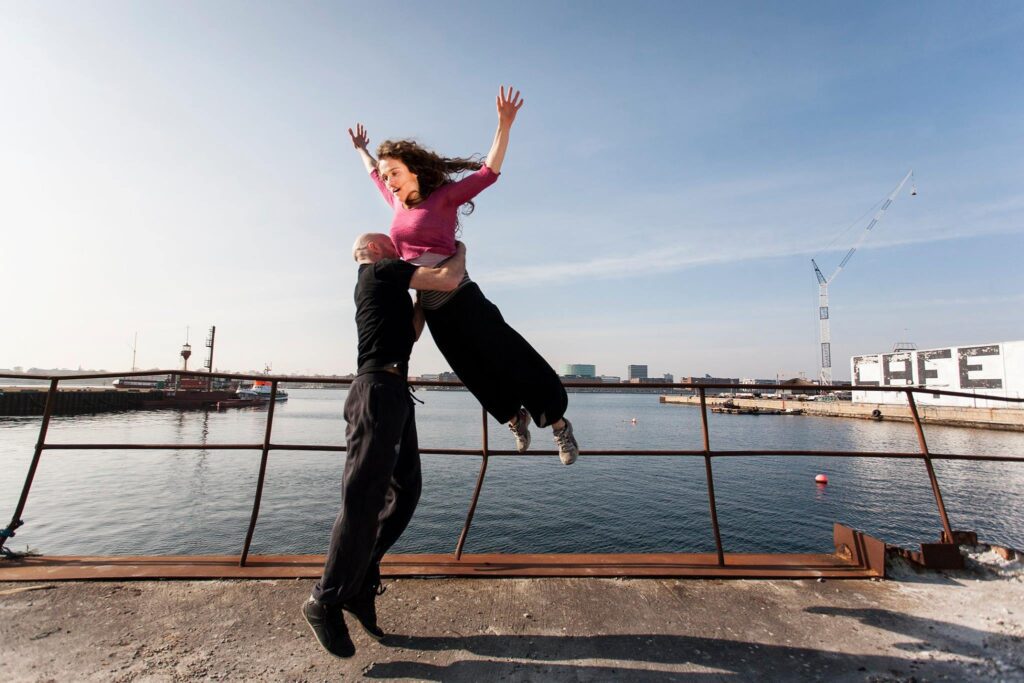
Give yourself some space and time. Make a cup of the, watch how the water is falling into your cup, feel the weight of the cup in your hand, and notice how the steam from your hot cup of tea is rising.
I wanna come back to this statement of gravity as something we all have in common. I’m attracted to universal forces on this planet, what they do to us, and we could use it as a way to break down polarities and try to focus on what it means that we have this force in common. I think it’s needed that we start to focus more on what we have in common and how it could bring us together in new ways. I believe in the power of difference sprouted out of a common ground, here in the words of Sarah Ahmed:
“Solidarity involves commitment, and work, as well as the recognition that even if we do not have the same feelings, or the same lives, or the same bodies, we do live on common ground.”
― Sara Ahmed
And our bodies are activated by this force, as a common ground and as a common movement toward the earth. We are all falling. Philosopher, word equilibrist and dancer Emma Bige expresses it as a STUDY OF THE EARTH IN US…
“All these movements which are in us…and which troubles the humanist idea according to which I would be the only subject of my movements” (Bige).
In the dizzying waltz of falling and rising and of human perception, the edges between self, environment, and species blur, leaving us with the profound question of where one begins and another ends.
The politics of mutuality
What does mutuality actually mean?. Try to say the word m u t u a l i t y. It sounds a bit like musicality. Without musicality there is no music. Without mutuality there is no
resonance
reciprocity
cooperation
respect
listening
support
intimacy
It requires an other, it requires a sensitive, listening and curious way of being. At one point I was teaching a lovely group of dancers/performers. We had a conversation about how to actually work together when given an exercise. In this case rolling up each other’s bodies. For some it just didn’t work when one was trying to push things through, and when one became too fixated on the end-goal which completely dismissed the process of trying to figure it out together. For it to work, it requires a sense of mutuality, a sense of give-and-take.
I would like to end this article with an excerpt from a nice conversation between Steve Paxton and Nancy Stark Smith (The Politics of Mutuality for Contact Quarterly):
SP:..I was really interested in seeing how Contact Improvisation guided us into it. In other words, how collaboration and mutuality could be the form around the activity. And I’ve always claimed that all of us made it.
NSS: After the initial impetus…
SP: After the initial impetus and getting a grant and arranging housing and…making up the work. I mean, my job was to make up a way to teach it. I had felt the form in my own body, and I wanted to find a way to express it to you guys. And I think you had all felt it in your bodies. But anyway, I couldn’t progress without collaboration. It’s a mutual form.
SP:… The politics of mutuality suggests collaboration; it doesn’t suggest monitoring the correctness of anybody’s behavior.
NSS: I wonder how you perceive this politics of mutuality and how it develops.
SP: First of all, all politics have an element of requiring more than one person. I don’t think you have a politics of yourself.
NSS: No, but there can be different kinds of power relationships between the players.
SP: Yeah. So the mutuality, the thing that’s inherent in the dance in the way that we defined it, was that there was to be a mutual listening to the movement. There was to be the creation of a third entity in the dance, which was the mutual movement paths and timing and all of that. That’s the way it was defined. So what we were doing was essentially defining power as not applicable.
NSS: Sort of circumventing power relations by doing that?
SP: Yeah. Like I pick you up and throw you around wasn’t part of the scheme. It was: if it is mutually…happening, then you do end up on my shoulder and I do…you know…
NSS: So how does anything happen if individuals aren’t deciding to do…
SP: That’s the miracle. That’s the phenomenon. That’s what we’re trying to find out. We’re trying to find out if anything happens if you have a really democratic situation.
…
SP: You can’t control. See, the word ‘control’ is not part of the politics of mutuality. It’s more influence. [NSS: Mmm!] It’s more like invite. It still requires two people, but it’s not a question of leader; it’s a question of follower. So if you have two people who are followers, what are they following is the question.
There’s the Small Dance; something is always happening there, so all you have to do is get into the Small Dance. Then I started saying: see if you can find an alignment with the other person’s Small Dance; see if you can follow the other person’s Small Dance—which is an initiation, but it’s an initiation…it’s not leading the other person’s Small Dance toward you or any kind of concept like that. It’s following, and it’s in alignment with that whole thing of the two followers. That the two followers create a …leading something.
We could also call it Composing Mutual Ties.
